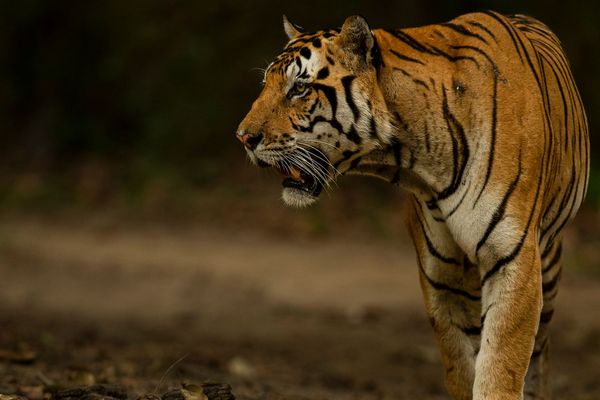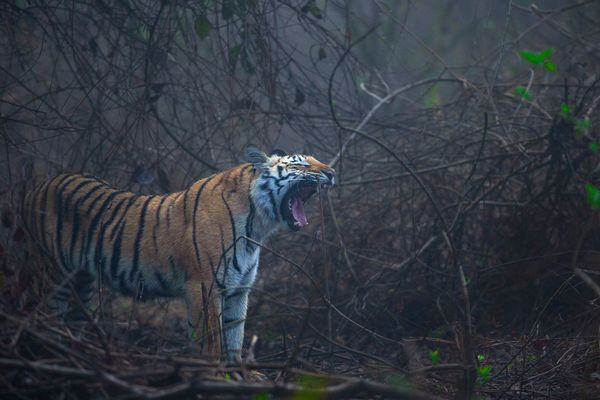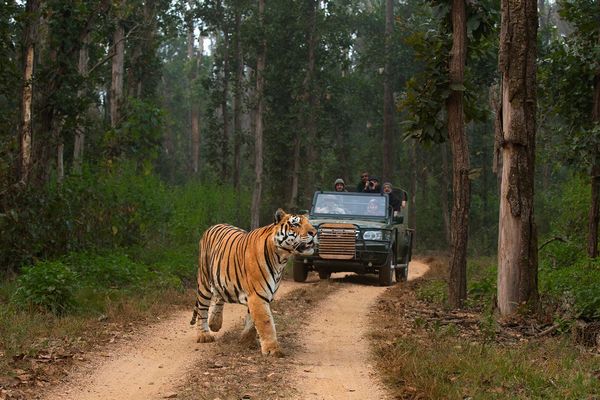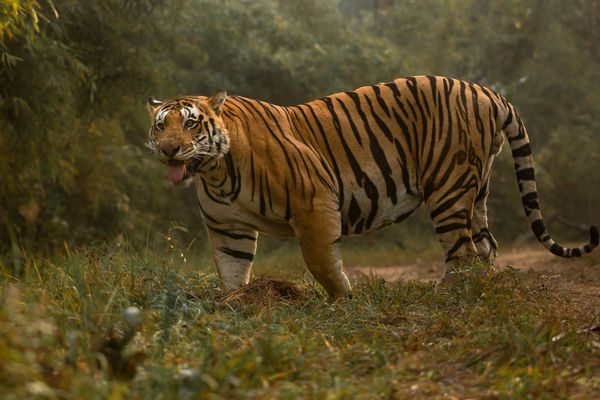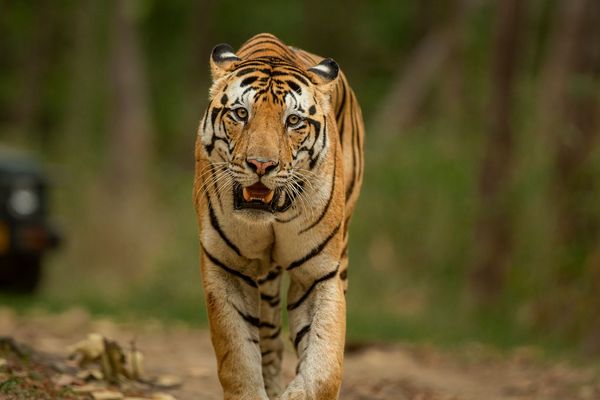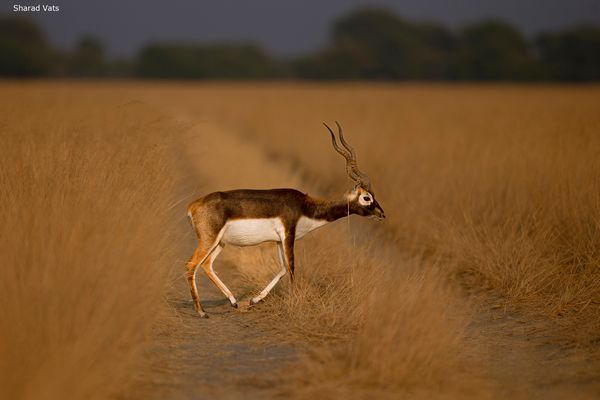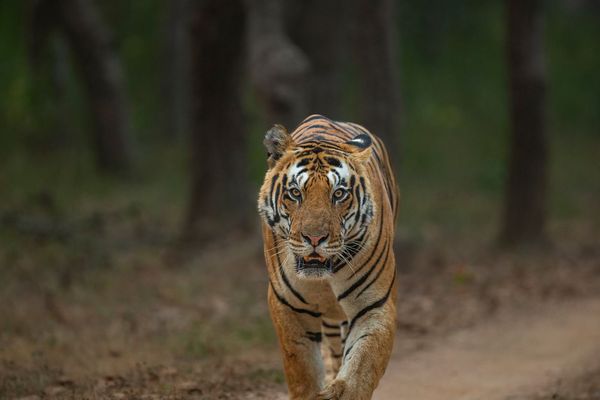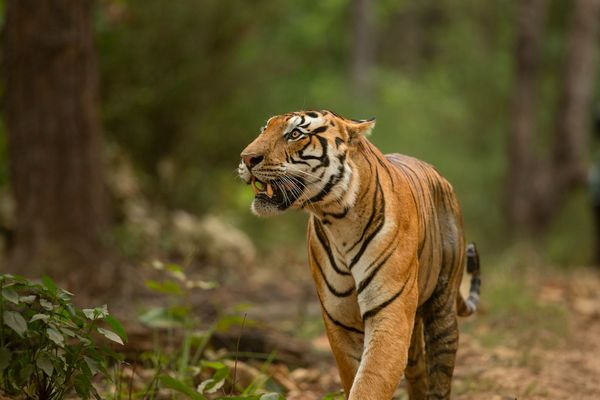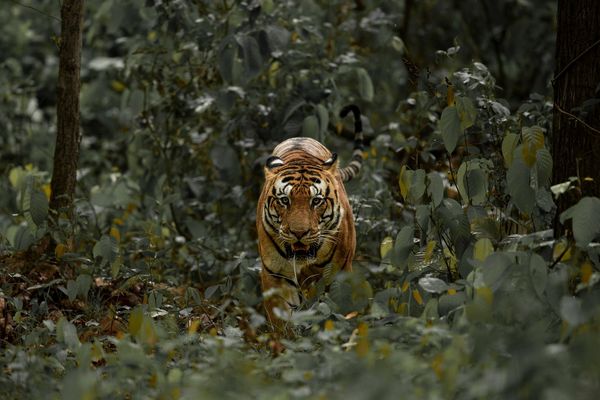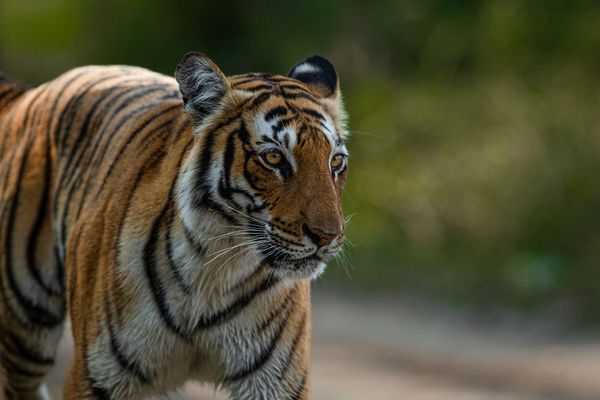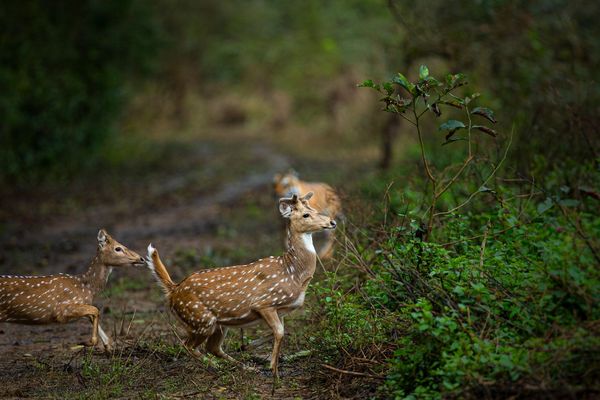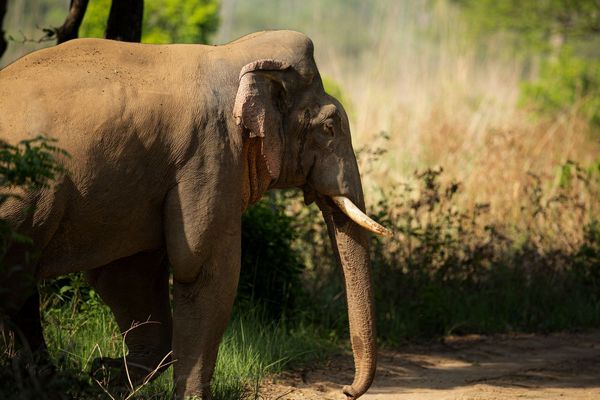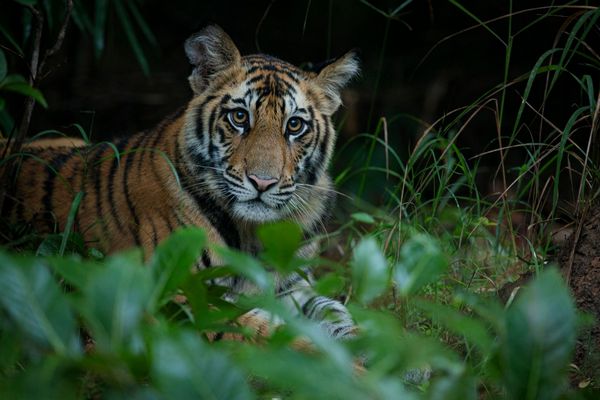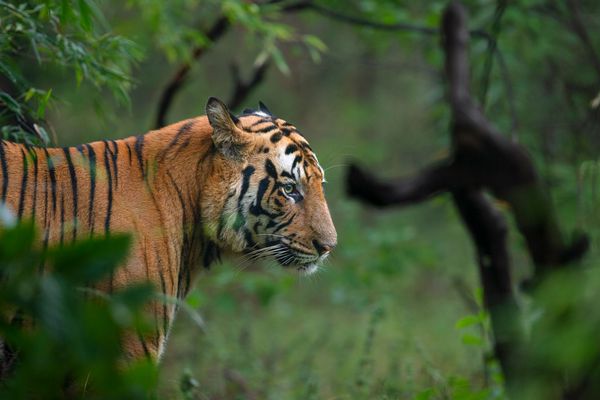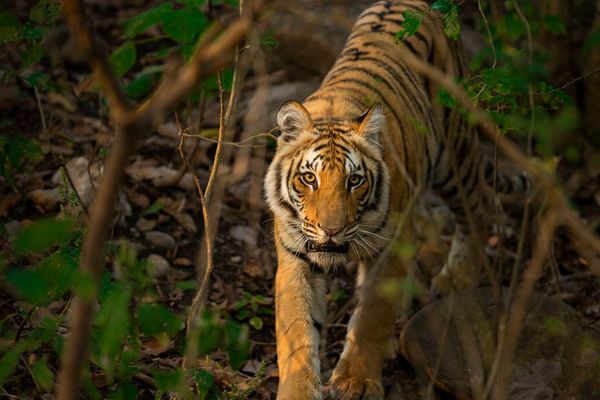Outline Tour Itinerary
- Day 01 : Arrival in New Delhi
- Day 02 : New Delhi – Agra (220 kms/4 hrs drive)
- Day 03 : Agra – Ranthambore (265 kms/5 hrs drive)
- Day 04 : In Ranthambore National Park
- Day 05 : In Ranthambore National Park
- Day 06 : Ranthambore – Jaipur (180 kms/3 hrs drive)
- Day 07 : Jaipur – Bera (390 kms/7 hrs drive)
- Day 08 : In Bera
- Day 09 : In Bera
- Day 10 : Bera –Udaipur – New Delhi200 kms/4 hrs drive + Flight)
- Day 11 : New Delhi – Onward
Guest Testimonials
TIGER SAFARI TOUR IN TIGER TAJ AND LEOPARD SAFARI OVERVIEW
When it comes to India’s culture and its wildlife, the Taj Mahal and tigers are two things that are inextricably linked. On the other hand, not a lot of people go out of their way to see the Leopard, which is yet another gorgeous cat. Jim Corbett once had the following to say about the leopard: “Those who have not seen a Leopard in its natural surroundings may have no understanding of the grace of motions, and the beauty of colouring, of this the most graceful, and the most beautiful of all animals we have in our Indian Jungles.” It’s not just his good looks that make him appealing; his strength is unparalleled for his size, and he has no equal when it comes to bravery. If you want to see this gorgeous and graceful animal, there is no better location to go than Bera. A stay here for three nights guarantees a nice sighting of a leopard, not just once but at least a couple of times, and there is a chance that you will even see the young cubs.
Ranthambhore is one of India’s national parks, and it was here that the Maharaja used to hunt tigers up until the country gained its independence. After that, he bequeathed it to the government so that it might be preserved. This hunter patrols his kingdom with an air of nonchalance today. Your very first glimpse of the Tiger will be imprinted in your mind for the rest of your life. It will be one of the top five things in this life that brings you the most joy. When you combine this trip with a visit to the Taj Mahal in Agra and a visit to Jaipur, often known as the “Pink City,” you get a crash lesson in what India is all about, including the Taj Mahal, temples, tombs, tandoors, and tigers.
Get a Quote
Let’s plan a perfect tiger safari tour for you. Please fill in the details and our representative will get in touch with you within 12 hours with a custom-made tiger safari tour package. You can also reach us directly on +91-9811200094 or email us at [email protected].
TIGER TAJ AND LEOPARD SAFARI TOUR Detailed Itinerary
- Day 1: Arrival in New Delhi
At the time of your arrival at the New Delhi Airport, a representative of our organisation will greet you. He will make sure that the transfer to the hotel goes smoothly and will also assist you with checking in at the hotel. You will be provided with all of the travel paperwork and given an explanation of their purpose. Staying the night at the Hotel is included.
- Day 2: New Delhi – Agra (220 kms/4 hrs drive)
You can expect to be greeted by our representative at the hotel, where they will also introduce you to our driver. Following breakfast, you will be transferred to your hotel in Agra. This is a trek of around 4 hours’ duration that covers a distance of 220 kilometres. Please check in at the hotel upon arrival. After that, you will see the Agra Fort, which is made of red sandstone and rises like a crescent on the banks of the Yamuna River. It is surrounded by formidable walls that are 20 metres high, and there is a moat that is 12 metres wide between the walls. This gigantic edifice, which was inspired by both Hindu and Muslim architectural styles, was constructed during the reigns of Akhbar, Jehangir, and Shah Jahan, three successive rulers of the Mughal Empire. [On Fridays, the Taj Mahal is closed.]
Overnight stay at Agra.
- Day 3: Agra – Ranthambore (265 kms/5 hrs drive)
Drive out into the forest for the morning game drive after getting an early wake-up call and warming up with a beverage of your choice. The morning calm is created as the sun rises over the hills of Sal and shines through the lush copses that cover the landscape. The park is alive with the chirps of a variety of colourful birds and provides a gorgeous vista as deer graze, monkeys chatter, and other small animals rush through the undergrowth.
After you’ve finished eating breakfast, which should be around 1000, start driving to Ranthambore National Park. The overall driving distance is 265 kilometres, and it will take you approximately five hours to cover it. After arriving in Ranthambore, you will first need to check in before going to lunch. After lunch, it’s time to head to Ranthambore National Park for your very first safari in the afternoon.
Ranthambore National Park is located in the state of Rajasthan and is made up of several different regions, each with its own unique history of conservation efforts. These regions are essentially isolated from one another by small passageways that connect them to the heart of the forest. The Ranthambore National Park, the Keladevi Sanctuary, and the Sawai Madhopur Sanctuary are the three separate sanctuaries in this region. The lodge provided both dinner and lodging for the night.
- Day 4 & 5: In Ranthambore National Park
A safari in search of tigers in the morning and the evening at Ranthambore National Park. The lodge provided all meals and a place to stay for the night.
In addition to its flora and fauna, Ranthambore is located in a region that is well recognised as the heart of the world’s most stunning avifauna. Avid bird watchers will find Ranthambore to be a veritable paradise, as it is home to more than 300 different species of birds. The Large Cormorant, the Painted Spurfowl, the Sarus Crane, the Bronzed Winged Jacana, the Sandpiper, the Kingfisher, the Nighjar, the Painted Sandgrouse, and the Great Horned Owl are just some of the interesting resident bird species that can be found in Ranthambore. Many other winter migrants travel from their breeding grounds in the Northern Himalayas to Ranthambore and the areas surrounding it.
Ranthambore covers an area of around 400 square kilometres. It gets its name from the thousand-year-old stronghold that continues to rise gracefully above the forest and encompasses steep hill crests that drop to open valleys between the Aravali and Vindhya hills. These valleys are lined with water ponds and fruit trees. Ranthambore is a very rare and unusual region where a natural present, meets a historical past. It is most well-known for the diurnal activity of tigers, which may be seen there. The mystical and ethereal atmosphere of this vast wilderness is embodied in the crumbling ruins that dot the landscape. Palaces and old guard stations are among the structures that contribute to Ranthambore’s unique character.
- Day 6: Ranthambore – Jaipur (180 kms/3 hrs drive)
Jeep excursion across the national park in the morning. After the morning safari, make your way to Jaipur by car. Traveling this distance by car should take you approximately three hours as it is 180 kilometres. After arriving, check into the hotel, and the rest of the day is yours to do as you like. The “Pink City” of Rajasthan, Jaipur, is the cultural centre of the Rajput people and is named after the colour pink, which symbolises hospitality. The land of fairy-tale palaces, rough strongholds located on desolate hills, and spacious avenues is quite photogenic and charming in appearance. Jaipur, which was the first city of its period to be designed, is surrounded by an intimidating wall. A place to stay for the night in Jaipur.
- Day 7: Jaipur – Bera (390 kms/7 hrs drive)
Drive all the way to Bera from Jaipur after you’ve had a big breakfast. To get to Bera will take you 390 kilometres and about seven hours of travel through the countryside. It has a proximity to the Jawai Dam due to its location in Rajasthan. The experience of seeing a leopard in the wild is one that cannot be compared to anything else because of how rare and wonderful these animals are. Leopards can be seen in the sandy village, so don’t expect to find yourself in a jungle or a forest here.
Bera is an attraction for wildlife fans to spot the elusive leopard, the enormous blue bull, crocodiles, the ever so mischievous hyena, the graceful pelican, the Greyleg Goose, Robin Accentor, Demoiselle Crane, and the Bar-headed Goose, to name a few of the animals that may be found there. Evening safari, dinner, and overnight at Bera.
- Day 8 & 9: In Bera
After eating breakfast, you will embark on a safari to see the beautiful sunrises and animals that Rajasthan is famous for. Safaris in the morning and afternoon, during which one may also observe rural life in Rajasthan. Every dinner was served at the lodge.
It’s not only the Leopards! Crocodiles are another amazing species of fauna that may be seen in the Bera region. What performers they are; 15-foot giants, they are capable of fooling everyone with their languidly lying illusions. What giants. Even when they are not actively hunting, they may still be just as active as when they are hunting. They will not move, and as a result, they occasionally blend in with the rusty, muddy terrain that is located close to the reservoir, making it difficult for us to spot them when we are some distance away. They lie in the sun for the entirety of the day and when they become hungry, they swim in the lake where there are plenty of fish to eat.
Even though they exercised all of their rights, the Maharajas helped to protect the forest and the species that lived there because of this. Bandhavgarh remained the private property of the Maharaja after the country gained its independence and remained that way until the Maharaja donated it to the state in 1968 so that it could be turned into a national park. The number of animals experienced a significant increase after the establishment of the park, which also led to an end to illegal hunting and poaching. In particular, the Tigers did very well, and the expansion that took place in 1986 supplied them with the additional forest habitat that they need. Rest your head at the resort for the night.
- Day 10: Bera – Udaipur – New Delhi
After breakfast, we will begin our journey from Bera to Udaipur. Take out from Udaipur and land in New Delhi on a flight. You will be greeted by a member of our staff upon your arrival in New Delhi, and they will accompany you all the way to the hotel in Delhi. Please spend the night at the hotel.
- Day 11: New Delhi – Onward
This morning is free for leisure activities. You will be later transferred to the International Terminal of the New Delhi Airport, to catch a flight back home/onward destination.
Enquire This Tour
Let’s plan your tiger safari tour. Please fill in the requirements below and our representative will get back to you with a custom safari package.
Guest Testimonials
What our guests are saying about us?

My husband and I did a 10 day "Just Tigers" safari. We visited Pench, Kanha and Bandhavgarh reserves. It was not high season but yes we had wonderful tiger sightings. The level of profession of these lovely people was so refreshing. For this type of trip you do want people who know what they are doing and a comfortable place to return to after long safari drives.

India. A country that has fascinated me for years. I finally decided it was time to visit and see it for myself. My husband and I both love nature, wildlife and birds so when I came across Nature Safari India I decided to make enquires.
We wanted to do the golden triangle tour as well as visiting national parks and seeing some of the ‘real’ India.

This is the 2nd time we have travelled with Nature Safari India. We had a 17 night holiday, visiting the nature of Sasan Gir National Park, Little Rann of Kutch, Velavadar Black Buck National Park and Leopard Hills at Bera. The nature was interspersed with various amounts of culture along the way. We had another amazing tour, with some stunning accommodation selected by the company

This was our second tiger safari at Corbett with Nature Safari and turned out to be worth every penny. We saw 7 tigers in 3 days and from quite close distance too. The best part was seeing a tigress wit her 2 grown cubs who crossed our path and walked in front of us for several minutes before crossing over and heading to a water hole where we saw them for hours drinking


